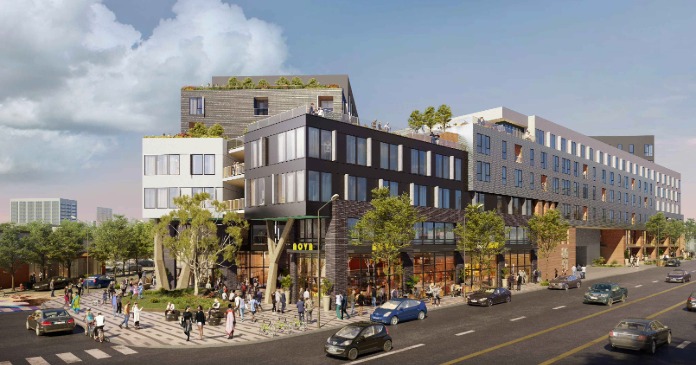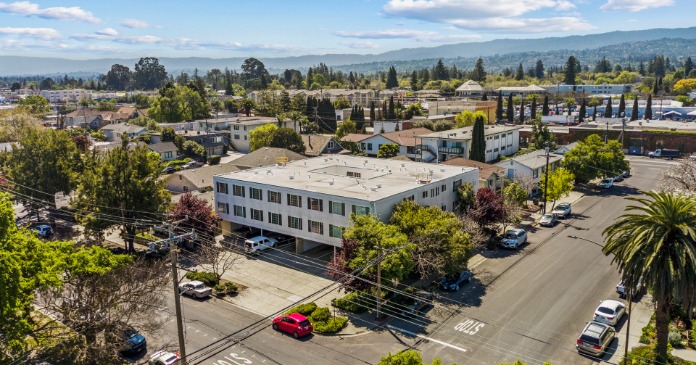Both ventures are transit-oriented, mixed-use and mixed income and are expected to achieve at least a LEED Silver rating from the U.S. Green Building Council (USGBC), attributes pegged as prime post-recession bets for real estate development, according to the 2010 Emerging Trends in Real Estate, released in November by Urban Land Institute/PricewaterhouseCoopers.
For-profit developer Othello Partners broke ground in July along a newly minted light-rail line one stop outside downtown Seattle for a mix of 351 apartments and 20,000 sq. ft. of street level retail. On the other side of the country near the Clarendon Metro Station in Arlington, Va., eight stories of apartments above two-stories dedicated to the Church of Clarendon are under construction by the Views at Clarendon Corporation, along with their development consultants The Bozzuto Group and Chesapeake Community Advisors, both specialists in market-rate and affordable housing development.
The need for transit-oriented development (TOD) is growing. Results from a 2004 study commissioned by the Federal Transportation Authority indicate that demand for housing near transit will increase to 14.6 million households by the year 2030, more than double the six million households that currently reside within a half-mile of transit. Historical evidence suggests that transit-supportive land use is clearly a critical piece of today’s economic recovery puzzle. After all, road building paved the way out of a downturn in the 1930s and 1950s. But even President Obama’s stimulus bill that earmarked $30 billion for infrastructure improvements and another $10 billion for public transit won’t create a building boom along transit routes while the economy remains soft and credit tight.
The elevated cost of land around transit stops makes it difficult for developers, even in flush times, to pencil projects that include housing for workforce and low-income residents–those who would benefit most from the cost savings associated with living near mass transit. Families who live in auto-dependent neighborhoods spend an average of 25 percent of their household budgets on transportation, but families who live near transit spend just nine percent, according to a 2007 study by Reconnecting America’s Center for Transit-Oriented Development, jointly funded by the U.S. Department of Transportation and HUD.
Building affordable housing typically requires multiple layers of financing from a variety of sources, and developers often must rely on state and local programs and policies to help with the costs. But they aren’t getting the support they need from the federal government, a September 2009 report by the U.S. Government Accountability Office (GAO) concludes. “HUD and Federal Transit Administration (FTA) programs allow local and state agencies to promote affordable housing near transit, but rarely provide direct incentives to target affordable housing in transit-oriented developments,” GAO reports.
Another major issue is the dwindling supply of existing affordable housing. As the value of land in transit-oriented, pedestrian friendly neighborhoods escalates, apartment owners are more likely to convert their affordable properties to market-rate, forcing low-income and workforce residents further away from city centers. Another study by Reconnecting America, the National Housing Trust and AARP, found that, while there are more than 250,000 affordable apartments located within one-half mile of public transit in the cities studied, more than two-thirds of the subsidies that keep those apartments affordable will expire within the next five years.
“Unfortunately, people talk about doing something to help spur development, but there really isn’t much out there,” said Steve Rauf, president and CEO of Seattle-based Othello Partners, who has assembled more than six acres of transit-oriented development parcels in south Seattle.
The falling value of low-income housing tax credits (LIHTC) to around $0.60 and the shrinking pool of tax credit investors is another substantial roadblock to creation of affordable and mixed-income TOD. Once hungry for affordable deals, Fannie Mae and Freddie Mac have lost their appetite for LIHTC. But the Tax Credit Assistance Program (TCAP), funded by the American Recovery and Reinvestment Act of 2009, has proved a blessing for LIHTC developers struggling to find investors. TCAP has allotted $2.3 billion to jump start stalled LIHTC projects and provides those funds directly to state housing finance agencies, which disperse the money to existing tax credit developments in need of additional gap funding.
Meanwhile, U.S. Department of Housing and Urban Development Secretary Shaun Donovan said in March that HUD would work in conjunction with the Department of Transportation to promote affordable housing in transit-oriented developments. Some state and local transportation departments already are working with developers to promote TOD through public/private partnerships.
Toby Bozzuto, president of Bozzuto Development, said his company is working closely with the Maryland Department of Transportation. “They have an incredible leadership there and understand urban planning beyond their mission of providing transit. I am convinced they will allow public/private partnerships. It’s going to take a lot of smart people and effort, but I think we will get there,” he said.
Faith, light-rail and hard work
The Bozzuto Group and development partner Chesapeake Community Advisors, Inc. (CCA) will break ground in December on the $46 million Views at Clarendon on behalf of nonprofit Views at Clarendon Corp. The mixed-use project will bring 116 units of mixed-income housing to Arlington County, Va., the smallest self-governing county in the U.S., situated across the Potomac River to the southwest of Washington, D.C.
Representatives of the First Baptist Church at Clarendon and members of Clarendon’s Interfaith Council and the Arlington County Board joined the development team to turn first dirt on the project that took six years of faith and hard work to bring out of the ground.
The site is owned by the church, which has served the community as a house of worship and provided day-care services for decades. In efforts to expand its ministry, the church created the Views at Clarendon, an independent 501(c)3 corporation, to demolish and rebuild the church, add 116 dwelling units in eight floors above it and retain the stand-alone building that currently houses Arlington’s largest day-care center that serves 185 children.
Arlington County, known for enlightened land use, was ranked first among walk-able cities in the United States by the American Podiatric Medical Association in 2005 and received the Environmental Protection Agency’s highest award for “Smart Growth” in 2002. Arlington’s County Board approved the Views at Clarendon in 2004, proclaiming it a rare opportunity to preserve childcare and increase the county’s supply of affordable housing within walking distance of a metro station. But fierce opposition from NIMBY groups delayed the project for years, as a $200,000 lawsuit played out in the courts.
The neighbors sued the county board over the building’s height and site rezoning, objecting to the 10-story structure that would also retain the church’s 107-foot steeple. The county prevailed in 2005, the neighborhood anti-development contingent appealed and, in September 2006, the Virginia Supreme Court reversed the circuit court judge’s decision, ruling in favor of the locals, based on a technicality.
The church and the Views Corp. re-filed their applications, which the county approved in February 2007, reaffirming its 2004 approval and making the needed technical changes to the zoning ordinance. In 2008, the church finally issued a request for proposal to solicit a third-party developer to get a long-stalled project on the road again.
Bozzuto and CCA joined forces to strengthen their chances of beating out the competition. “Both our companies have a great deal of experience in affordable housing. Together we competed and subsequently won the right to negotiate with the church and the Views Corporation,” said the president of Bozzuto Development, one of six arms of The Bozzuto Group. Bozzuto’s construction arm is acting as the general contractor for the project, CCA is serving as financing consultant and Bozzuto Management Company eventually will fee-manage the property.
The church also hired the Arlington Partnership for Affordable Housing (APAH) to guide it through the affordable housing process. Dedicated to developing, preserving, and owning quality housing that is affordable and enhances the Arlington County community, APAH is the only nonprofit affordable housing developer to work exclusively in and for the county. In the 20 years since its founding, APAH has developed a $150 million portfolio of 10 residential properties there.
When the development team came aboard, the site plan for the Views at Clarendon was approved and all that remained was the monumental task of assembling the numerous financing pieces to enable the team to move ahead with construction. “Our job was to put together a financing plan that would make this project a reality and that was our biggest challenge. I don’t think that when we came into the process it had a viable financing plan. We’re not even sure it had viable construction numbers,” said CCA VP Ben Etheridge, a tax-credit specialist, who manages the company’s development and consulting activities.
Although construction costs have come down a bit over the past year, they had increased significantly since the project’s original approval. “Over the past five years, on a macro basis in the D.C. area, we’ve seen something like a 20 percent annual escalation in construction costs. So you add that up over five years and you’ve got a big problem. Now, are we down 10 to 20 percent today versus last year? Sure. But it’s still drastically different than it was when the project received its tax credit allocation,” said Bozzuto.
Tax credits also lost significant value over the past few years, but what surprised the team most was the lack of investor interest in the planned development. “This project has a banner location and a large allocation of credits and we thought there would be really strong interest. But there was a lot of concern about the mixed income and the risk of market-rate units. Tax credit investors can be very picky and only choose very vanilla projects. That surprised all of us,” said Vicki Vaughn, an affordable finance and development expert and specialist in low-income, historic and new markets tax credits currently serving as consultant to CCA on development, finance and portfolio projects.
The developers were able to fill the financing gap with support from the Tax Credit Exchange Program. “We exchanged 100 percent of our credits through the Virginia Housing Development Authority’s (VHDA) tax credit exchange program. What might have been equity from a corporate investor is now actually a grant from VHDA and it really was a piece that helped make this project happen,” she said.
The project received $18.9 million in tax credit exchange grant funds and $14.5 million in taxable bond financing from the VHDA. The Arlington Housing Investment Fund, a pot of money Arlington County has set aside to help finance affordable housing, provided a second lien loan of $13.1 million. Another $2.7 million in predevelopment financing came from the Mercy Loan Fund, a subsidiary of the national affordable housing organization Mercy Housing, which provides financing to hundreds of local nonprofit organizations, enabling them to build or preserve affordable housing in their communities.
The church also made a significant financial contribution, mortgaging its property and investing $3.5 million in the development. The church portion of the building is financed separately and solely from church sources.
The Views at Clarendon site is half a block from the Clarendon Metro Station within the Wilson-Clarendon corridor, considered one of the top ten urban corridors by the American Planning Association this year. The comparatively healthy state of the Washington, D.C., market is another plus for the project. “We have an economic engine other parts of the country don’t have. The nation’s capital benefits from the federal government and its ancillary industries and businesses, so, when government expands, D.C. expands, and clearly we are in a bit of an expansion mode at the moment,” said Bozzuto.
The 10-story development, designed by locally based MTFA Architecture, Inc., will include a mix of 17 efficiencies, 61 ones, 32 twos and six three-bedroom units above two stories dedicated to the church. Units will range from 587 to 1,360 sq. ft. Market-rate rents will range from $1,950 to $2,750. A total of 70 apartments will be set aside as affordable, including six handicapped accessible units and another three for the hearing impaired.
Residents will benefit from environmentally-conscious features and products like Energy Star appliances, HVAC, common area lighting, windows and programmable thermostats, as well as dual-flush toilets, low-VOC paint and carpet and recycling centers on every floor. The community also provides storage for 70 bicycles, a carpool drop-off area and one parking spot per unit. A courtyard at the center of the development will include a life-size chess and checker board and will share space and playground equipment with the daycare operation.
Plans call for demolition of the church, but the steeple from the original 1950s structure will be preserved. “The existing adjacent daycare building will remain and we will dig down for 120 underground parking spaces and come back up and build two floors of church space and then the eight-floor residential building. Our plan is to deliver floor by floor beginning in the fall of 2011,” said Bozzuto VP Doris Topel-Gantos.
“We usually try to lease a few floors in advance of the opening date, so that we don’t get all of the units at once. It’s really just a little bit of pre-leasing,” said Bozzuto.














